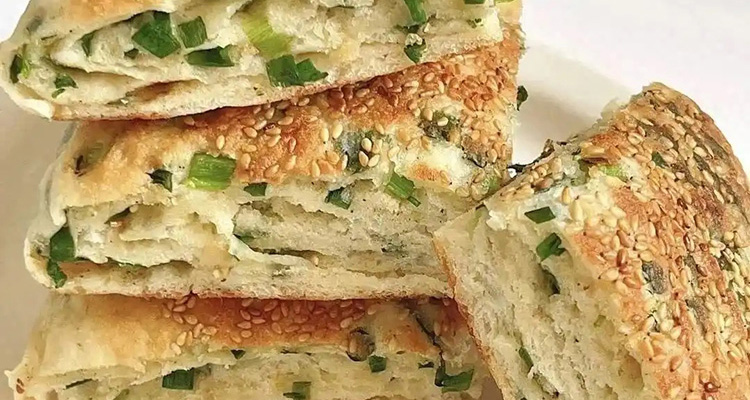Shanghai Qiangbing: Crispy Breakfast Flatbread
In the early hours of Shanghai, a warm, toasty aroma drifts from the lanes—the scent of Shanghai Qiangbing. For many locals, a day truly begins with a steaming, golden Qiangbing: a crisp exterior giving way to soft, layered interior. This humble yet soulful snack is a hallmark of Shanghai breakfast culture and an irresistible introduction for travelers seeking authentic Chinese street food. If you want to experience local life, a fresh Qiangbing is a must-try.
Origins and History: From Street Food to Culinary Legend
The roots of Shanghai Qiangbing stretch back to the late Qing and early Republican era, when Shanghai’s role as a trading port blended northern and southern culinary traditions. Qiangbing emerged from that fusion—combining the robust textures of northern breads with the refinement of southern pastries. Some stories say the name “Qiangbing” came from migrants from northwest China, bringing distinct techniques and flavors to the city. Over decades, Qiangbing evolved from a simple street offering into a beloved local specialty, carrying decades of memories for generations of Shanghainese.
Cultural Significance: The Flavor of Lane-Life
Qiangbing is more than food in Shanghai—it’s part of the city’s social fabric. You’ll find it in corner vendors, modest breakfast shops, and even on menus at time-honored restaurants. It’s the taste of childhood mornings, a quick grab on the commute, and a nostalgic treat on a leisurely weekend. Qiangbing reflects Shanghai’s pragmatic yet refined lifestyle: straightforward ingredients prepared with technique to deliver layered flavor. Today, amid culinary diversity, Qiangbing remains a go-to local snack and an authentic experience for visitors.

Key Ingredients: Simple Components, Remarkable Taste
The magic of Qiangbing lies in its modest ingredients: high-gluten wheat flour, yeast, sesame seeds, scallions, a pinch of salt, and oil. Choosing the right flour helps the flatbread achieve a crisp outer layer while staying tender within. Yeast fermentation creates the subtle airiness and layered texture. Toasted white sesame seeds lend a nutty aroma, and fresh scallions add a bright, savory note. These simple elements combine to produce a complex, comforting taste.
Making Qiangbing: Artisanship in Every Step
Crafting Qiangbing demands patience and technique. Start by mixing flour, yeast, and warm water into a smooth dough and let it rise until doubled. Roll the fermented dough into thin sheets, sprinkle evenly with scallions, sesame seeds, and a little salt, then roll into logs and coil into rounds. This rolling and coiling is essential—it creates the multiple layers that give Qiangbing its signature texture. Traditionally, vendors pan-fry the rounds over medium-low heat until both sides turn golden, occasionally finishing them in a hot oven or covered pan to ensure the interior cooks through while the crust crisps.

Flavor and Texture: Crunchy Outside, Soft Inside
Take a bite and you’ll discover the defining contrast: a golden, crunchy crust with the toasty fragrance of sesame and a hint of oiliness, leading to a soft, layered interior carrying the mellow wheat aroma and the fresh bite of scallions. Served hot, the crispiness is most pronounced; as it cools, the inner layers reveal their chewiness and nuanced texture. Qiangbing pairs equally well solo or with a warm bowl of soy milk—each bite is a small moment of delight.
How to Eat It: Tasting Tips for Travelers
Locals typically enjoy Qiangbing as breakfast or a light snack. Vendors often slice fresh Qiangbing into bite-sized pieces so you can savor the texture immediately. Pair it with hot soy milk, savory tofu pudding, or a small bowl of noodle soup for a complete, traditional breakfast. For first-time tasters, try it plain to appreciate its original aroma; if you like bolder flavors, experiment with chili sauce, sweet fermented bean paste, or soy-based condiments. The best time to eat Qiangbing is piping hot, when the contrast between crisp crust and tender layers is most satisfying.

Where to Find the Best Qiangbing: Local Tips
To find authentic Qiangbing in Shanghai, follow these tips:
- Explore old-town neighborhoods: areas in Huangpu and Jing’an districts still host long-running breakfast stalls.
- Look for shops making Qiangbing on-site: fresh, on-the-spot preparation usually indicates superior flavor.
- Follow the locals: lines of middle-aged regulars often point to quality and tradition.
- Pairing suggestion: order Qiangbing with savory soy milk or tofu pudding for a classic combo.
- Best time: early morning between 6:00 and 9:00, though some specialty shops serve them all day.
Easy Home Recipe: Recreate Shanghai Flavor at Home
If you can’t make it to Shanghai, try this simplified home version of Qiangbing—designed for a household kitchen:
Ingredients: 200g all-purpose flour, 3g active dry yeast, 100ml warm water, handful of chopped scallions, 1–2 tablespoons white sesame seeds, pinch of salt, 1–2 tablespoons cooking oil.
Steps:
- Dissolve yeast in warm water for 5 minutes. Mix into flour and knead until smooth. Cover and let rise about 1 hour, until doubled.
- Roll the dough into a rectangle on a lightly floured surface. Brush a thin layer of oil, sprinkle salt, scallions, and sesame seeds evenly.
- Roll the sheet tightly into a log, then coil the log into a round patty. Gently press flat with your palm or a rolling pin.
- Heat a nonstick pan over medium-low heat, brush with a little oil. Cook the patty 5–6 minutes per side, covered briefly to help it cook through, until both sides are golden and crisp.
- Slice into wedges and serve hot. Enjoy with soy milk, tofu pudding, or your favorite dip.
This home method captures the essential flavors and textures of Qiangbing, making it accessible for home cooks.

Conclusion: Start Your Shanghai Food Journey
Shanghai Qiangbing is more than a snack—it’s a small cultural emblem of the city. With simple ingredients, thoughtful technique, and warm, nostalgic flavor, it connects you to generations of Shanghai mornings. Whether you’re a foodie or a cultural explorer, seek out a fresh Qiangbing at a local stall and let its aroma and taste transport you into the heart of Shanghai life.


